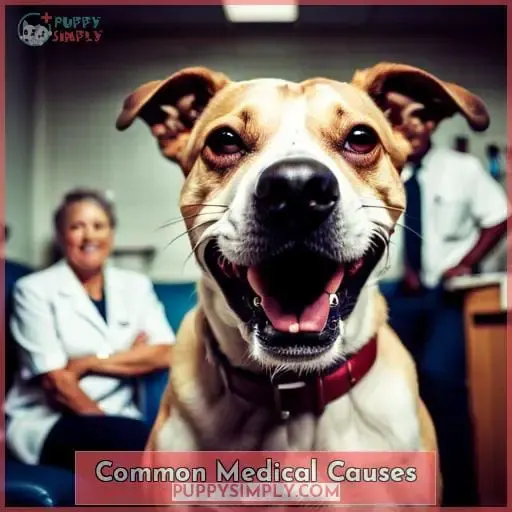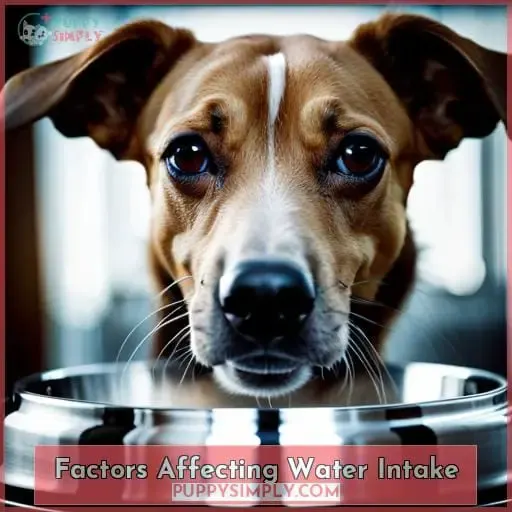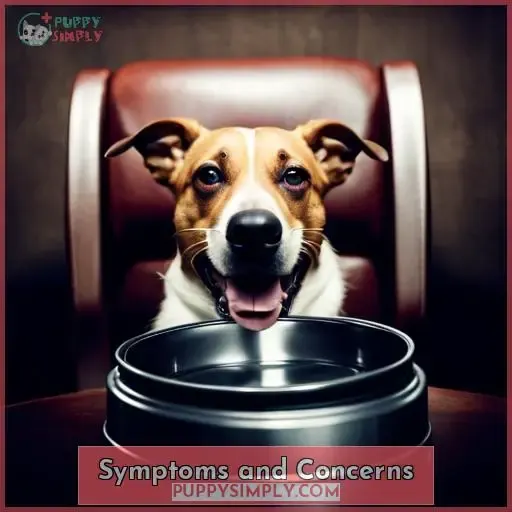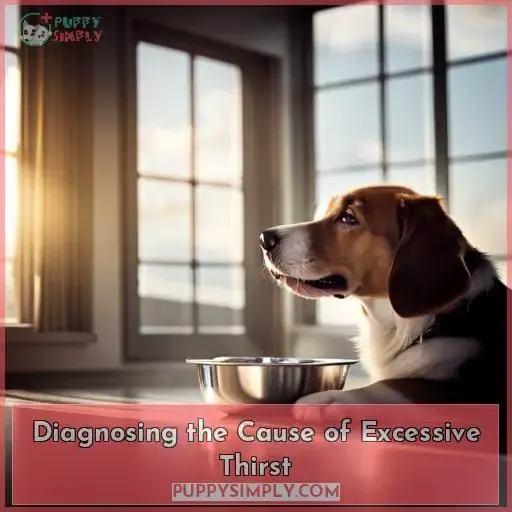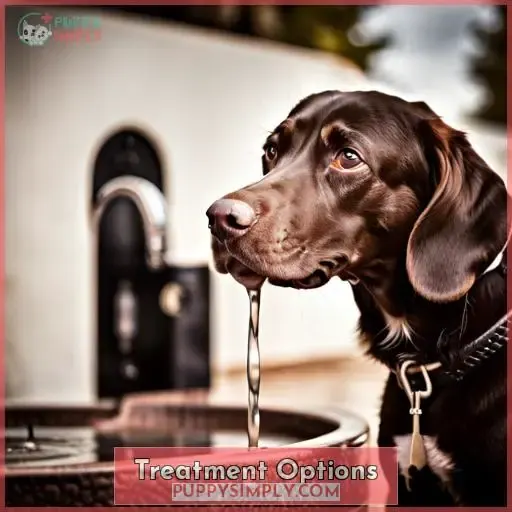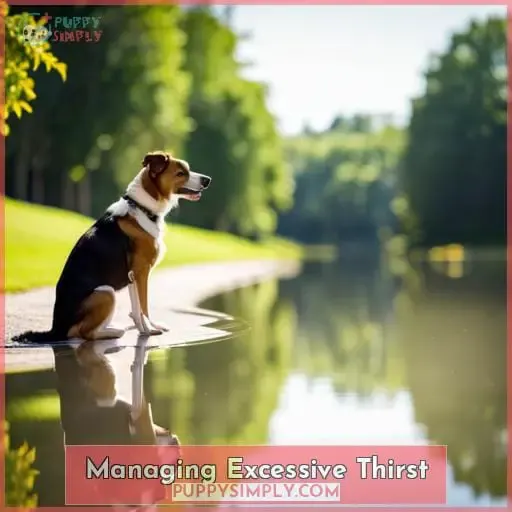This site is supported by our readers. We may earn a commission, at no cost to you, if you purchase through links.
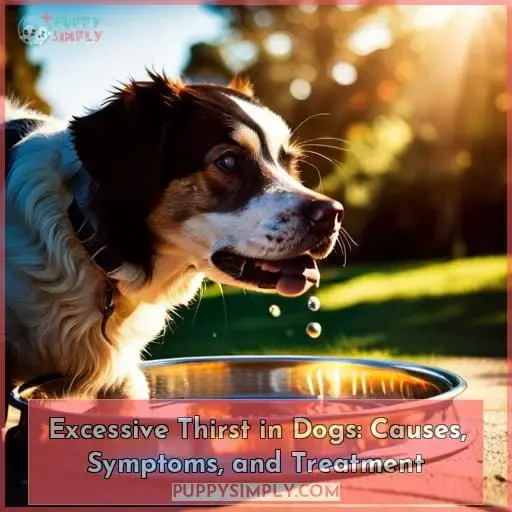 Do you find yourself constantly refilling your dog’s water bowl? If so, it could be a sign of something more serious. Excessive drinking in dogs is often accompanied by increased urination and can be caused by various medical conditions such as kidney failure, diabetes mellitus, or Cushing’s disease.
Do you find yourself constantly refilling your dog’s water bowl? If so, it could be a sign of something more serious. Excessive drinking in dogs is often accompanied by increased urination and can be caused by various medical conditions such as kidney failure, diabetes mellitus, or Cushing’s disease.
Knowing the causes and symptoms of excessive thirst in dogs can help owners identify when they should seek veterinary care for their pup. In this article, we will explore common medical causes, factors affecting water intake, associated symptoms to watch out for, and treatment options available for managing dog excessive drinking.
Table Of Contents
Key Takeaways
- Excessive drinking in dogs can be a sign of underlying health issues such as diabetes mellitus, kidney disease, Cushing’s syndrome, and pyometra.
- Factors such as diarrhea, vomiting, environment, diet, and medications can affect a dog’s water intake.
- Dogs generally need 1 ounce of water per pound of body weight daily, but this can vary depending on factors such as canned food diets, hot climates, frequent exercise, aging, and puppies.
- Symptoms of excessive thirst in dogs include vomiting, paw licking, increased urination, and nighttime thirst, and veterinary care should be sought if concerned.
Common Medical Causes
Excessive thirst in dogs, or polydipsia, is a common concern among dog owners. Common medical causes of excessive thirst include diabetes mellitus, kidney disease, Cushing’s syndrome, diarrhea or vomiting, pyometra, and other conditions such as dehydration and liver disease.
It is important to contact your veterinarian if you notice increased water consumption in your dog for an accurate diagnosis and treatment plan.
Diabetes Mellitus
If you notice your pup’s water intake increasing, it could be a sign of diabetes mellitus, an illness marked by high blood sugar and frequent urination. Symptoms include excessive thirst and urination, weight loss or gain, fatigue, poor coat condition, and other signs.
Management includes dietary changes such as diabetic dog food to maintain healthy glucose levels, monitoring blood glucose with the vet’s help, regular exercise, and administering insulin injections if needed.
Early diagnosis is crucial for successful management of canine diabetes, so seek veterinary care immediately if any symptoms arise in your pet.
Kidney Disease
Kidney disease can cause your pup to drink more water than usual. It’s important for pet owners to be aware of the symptoms and causes, as this allows them to take proactive steps in managing kidney health.
Veterinarian visits are essential for diagnosis, treatment recommendations, and monitoring progress over time. To prevent kidney problems from occurring or worsening in dogs with existing conditions, it is recommended that they follow a renal diet plan low in sodium and phosphorus.
They should also stay hydrated throughout the day by drinking adequate amounts of fresh water from spill-resistant bowls kept clean at all times.
Additionally, look out for signs of dehydration such as sunken eyes or thick saliva so you can act quickly if needed!
Cushing’s Syndrome
Cushing’s syndrome, an endocrine disorder caused by adrenal gland problems, can cause your pup to be unusually thirsty. Signs of Cushing’s in dogs include increased appetite and urination, hair loss or thinning coat, potbellied appearance with muscle wasting, and panting.
Treatment options for Cushing’s include medication like trilostane or mitotane, as well as surgery to remove the affected glands. Veterinarians may use a combination of blood tests and imaging techniques such as X-ray or ultrasound for the diagnosis process.
Living with this condition requires regular vet visits, along with monitoring water intake closely to prevent dehydration due to excessive drinking associated with it.
Diarrhea or Vomiting
Diarrhea or vomiting can cause your pet to drink more water as they lose body fluids. Managing dehydration and preventing vomiting is essential for maintaining your dog’s health.
Look out for signs of dehydration such as fatigue, dry gums, reduced skin elasticity, and thick saliva. There are a variety of causes that may lead to diarrhea or vomiting in dogs. These include dietary indiscretion, gastrointestinal parasites, infections from bacteria or viruses, and even certain medications like antibiotics.
Treatment will depend on the underlying cause, so it is important to seek veterinary advice promptly if you notice any changes in their drinking behavior or other symptoms associated with diarrhea/vomiting, such as lethargy and loss of appetite.
Hydration tips include providing clean drinking water at all times when outdoors, especially during hot weather.
Pyometra
If your pup is drinking more than usual, pyometra might be the culprit. Pyometra in female dogs occurs when their uterus becomes infected and can lead to increased water consumption. Complications of this condition include organ failure and sepsis if left untreated.
Treatment options usually involve antibiotics combined with surgery to remove the uterus or ovaries as well as IV fluids for rehydration purposes. To prevent pyometra from occurring, spaying should be done at an early age before permanent damage takes place due to infection buildup over time in a dog’s reproductive organs.
Diabetes insipidus caused by kidney malfunction can also result in excessive thirst at night along with increased water intake during the day.
Other Causes of Excessive Thirst in Dogs
From liver infections to electrolyte imbalances, there are a variety of medical issues that can cause your pup to drink more than usual. These include dehydration, fever, infection, cancer, and hypercalcemia. Hydration monitoring is critical for senior dogs or those with kidney failure.
Knowing the triggers of thirst helps you recognize when it’s time for a vet visit. Common triggers include diarrhea/vomiting, medications like prednisone, high-sodium foods, and heatstroke. To prevent dehydration, ensure a daily intake of 1 ounce per pound and provide assistance during outdoor activities in hot weather.
Use spill-resistant bowls and keep them clean and filled. If you are concerned about your dog’s water consumption, contact a vet promptly as multiple conditions can affect hydration levels in dogs, leading to serious health risks if left untreated.
Factors Affecting Water Intake
It’s important to understand how environmental factors, diet, and medications can affect your dog’s water intake. A good guideline for daily water consumption is 1 ounce per pound of body weight.
When deciding on a diet plan for your pup, it’s important to consider that canned food contains moisture. This should be taken into account when determining the amount of water your dog needs.
Older dogs may not drink as much water due to age-related health problems. On the other hand, in hotter climates or with frequent exercise, dogs require increased amounts of hydration.
It’s also important to note that certain medications, such as diuretics and corticosteroids, can stimulate thirst in pets.
Daily Water Intake Guidelines
It’s important to provide your pup with at least 1 ounce of water per pound of body weight daily. Regular hydration monitoring is essential for all dogs, especially in hot climates and during periods of physical activity or illness.
Monitor drinking habits and be aware that puppies may need more fluids due to their increased activity levels. Signs of canine dehydration include fatigue, dry gums, reduced skin elasticity, and thick saliva production.
Dogs on certain medications, such as prednisone, may drink more water than usual. Canned food can also reduce the amount of water needed since it contains moisture content already present in the diet.
If you notice excessive peeing or other urinary behaviors in your dog, consult a veterinarian promptly for proper diagnosis and treatment.
Canned Food Diet
Switching to a canned food diet can reduce your pup’s water consumption since it contains moisture. This type of wet food is high in protein and fat content, making it more filling for dogs with smaller appetites.
Canned food provides essential vitamins and minerals needed for optimal health. Its higher moisture content also helps keep your pup hydrated throughout the day.
Feeding senior dogs moistened or pureed foods is an effective way of managing canine thirst due to age-related conditions like liver disease or medication side effects that may lead to excessive drinking.
When considering what type of diet will best suit your pet’s needs, remember that fresh clean water should always be available at all times!
Age
At any age, your pup’s water intake can be affected. Aging dogs may experience symptoms of Cushing’s disease, such as increased thirst or dehydration, due to reduced kidney function. Senior dogs are especially prone to dehydration and should have plenty of access to clean drinking water.
Puppies need more hydration than older adults due to their high activity levels and less concentrated urine. Age-related causes like diabetes mellitus, fever, infections, or electrolyte imbalances also affect a dog’s hydration needs.
- Diabetes Mellitus
- Fever & Infections
- Electrolyte Imbalances
- Reduced Kidney Function
- High Activity Levels
Medications
Certain medications, such as prednisone and furosemide, can cause your pup to guzzle down H2O – even if they don’t normally have a penchant for excess hydration. If you notice this behavior in your dog while on these or other drugs, contact the vet right away.
Medication side effects like electrolyte imbalances and dehydration can be serious. Talk to the vet about managing hydration levels with canine drug interactions in mind; adjust dosages accordingly and keep an eye out for any changes that may occur after administering certain veterinary prescriptions or changing medication dosages.
Laboratory tests are recommended to help determine underlying issues causing increased water consumption due to stress caused by certain meds; prompt diagnosis is key when it comes to treating excessive drinking in dogs!
Hot Climates
When the temperature rises, your pup will need extra water to stay hydrated and healthy. Hot climates can quickly lead to dehydration in dogs if they don’t drink enough fluids. Puppies and active dogs are particularly susceptible due to their higher energy levels.
You should always bring a bowl of fresh water with you when exercising or taking your pup out during hot weather. To prevent dehydration, monitor your dog’s water intake closely, especially after frequent exercise or extended outdoor activity periods on hot days.
Ideally, most breeds should consume more than 1 ounce per pound of bodyweight daily.
Early signs of dehydration include lethargy, dry gums, and thick saliva. If you notice any symptoms, take immediate action by providing lots of clean drinking water as soon as possible!
Frequent Exercise or Increased Activity
Your pup’s water bowl may need frequent refills if they’re doing a lot of running around. Exercise, play, and activity can significantly increase a dog’s water intake – more than just the 1 ounce per pound of body weight.
Dogs that are active need extra hydration to prevent dehydration and electrolyte imbalances. This is especially true in hotter environments or when on medications like diuretics or corticosteroids.
If excessive thirst persists beyond normal levels during physical activities, look for other causes such as liver infection from Leptospirosis or diabetes mellitus, which requires immediate veterinary attention.
Symptoms and Concerns
Observing the amount of water your dog is drinking can be essential to its health. Excessive thirst in dogs may indicate an underlying condition, and common symptoms include vomiting after drinking, excessive paw licking or constant panting, increased urination, and more frequent nighttime water consumption.
Drinking Water and Throwing Up
If your pup is drinking an excessive amount of water and throwing up, they may have a medical condition that requires prompt attention from your vet. Vomiting after drinking can be caused by dehydration or electrolyte imbalances due to various health issues.
Paw licking and hydration should also be monitored as too much licking could indicate dehydration or pain-related problems. Observe any changes in thirst and urination patterns for further insight into their overall health status.
Water consumption at night can increase if the environment is dry, so try increasing humidity with extra bedding or a humidifier to reduce this symptom.
Drinking Water and Licking Paws
Notice if your pup is drinking a lot of water and licking their paws excessively, as this could be an indication of underlying health issues. Excessive paw licking can signal physical pain or anxiety in dogs. It’s important to identify the cause so that appropriate treatment can be sought out.
For instance, managing chronic pain with medication or helping them manage stress through behavior modification exercises.
Dogs may lick their paws due to allergies, dry skin conditions like dermatitis, wounds from nails being too long and digging into the pads of feet — any number of things! If you suspect something more serious than just overgrooming behavior such as infection or parasites, consult your vet immediately before trying any home remedies yourself.
Anxiety-related behaviors will need special attention on top of medical solutions.
Drinking Water and Increased Urination
Be aware that if your pup is drinking more water than usual, they may also be urinating more frequently. The increased hydration can cause a sodium imbalance, which leads to excessive urination. This frequent need for relief could indicate underlying health issues such as diabetes mellitus or kidney disease.
It’s important to keep an eye on your dog’s hydration patterns and take note of any changes in their behavior.
A vet visit should include a urine sample, inspection of the pup’s eyes and mouth, and other tests needed to rule out medical conditions causing this sudden increase in water consumption. Hydrating too much has serious implications for dogs’ health, including electrolyte imbalances.
Drinking Lots of Water at Night
It’s not uncommon for your pup to drink more water at night, which could be due to dehydration or other medical conditions. Nocturnal hydration patterns can indicate potential health issues such as diabetes mellitus, Cushing’s disease, hyperthermia, or liver infection.
Sleep disruption and excessive drinking may also signal a problem. If you notice any changes in your dog’s nighttime water intake, it’s important to bring them in for lab tests and an examination by their vet right away.
By addressing the cause of your pet’s nocturnal thirst early on, you can help keep them healthy and prevent further complications down the line.
When to Seek Veterinary Care
If you’re concerned about your pet’s water intake, don’t hesitate to seek veterinary care. Excessive thirst in dogs is a warning sign of underlying health issues that require medical attention. Dehydration can have serious implications for pets and should be addressed immediately with an urgent vet visit.
Your veterinarian will need information from you on the dog’s diet, lifestyle habits, and recent activities to assess its current condition before making any diagnosis or treatment recommendations. Blood tests may be necessary to look for signs of infection or cognitive dysfunction.
Other diagnostic tools, such as acth stimulation testing, might also be suggested by your vet if they suspect Cushing’s disease or leptospirosis infection.
If it turns out that pyometra is causing excessive thirst, then surgery and antibiotics are likely needed. Fluid therapy can also help restore electrolyte balance in the body quickly when dehydration concerns are present at the same time as increased drinking behaviors become concerning over multiple days, rather than just one day due to activity level changes alone.
Diagnosing the Cause of Excessive Thirst
If your dog is drinking a lot of water and it doesn’t seem to be due to environmental or activity factors, it may be time to seek veterinary care. A vet will conduct a physical exam and run tests such as bloodwork, urinalysis, X-rays, ultrasound, and more specific tests for underlying conditions.
This helps assess kidney function while ruling out diabetes mellitus or Cushing’s syndrome, which are common medical causes of excessive thirst in dogs. Dr. Sarah Wooten from the UC Davis School of Veterinary Medicine stresses that dehydration symptoms should never be ignored.
They include seeking water often, fatigue with sunken eyes, dry gums, and urinary tract infections (UTI).
Canine hydration is essential for maintaining health, so if you suspect an issue with your pet’s increased intake of fluids, contact your veterinarian immediately for help in diagnosing the cause quickly before any further complications arise!
Veterinary Examinations and Tests
When your pup is excessively drinking, a vet visit can include tests to help uncover the underlying cause. Veterinary examinations and diagnostic tests involve medical evaluations of water intake, physical exams, bloodwork, urinalysis, and other specific tests that rule out conditions like diabetes or Cushing’s syndrome.
The vet may also take urine samples for laboratory analysis to assess kidney function as well as liver health. A complete blood count will provide information on red cell and white cell levels in the bloodstream, which is crucial for diagnosing infection or disease states such as anemia or leukemia.
Lastly, X-rays and ultrasound imaging are performed when necessary to further investigate if there are any structural abnormalities inside your dog’s body affecting their thirst levels, such as tumors causing dehydration due to increased fluid loss through excessive urination.
All these assessments work together so that veterinarians can identify what could be making your pup drink more than usual, providing them with relief from whatever is bothering them!
Treatment Options
Depending on the cause, treating your pet’s excessive drinking may involve medication, fluid therapy, dietary changes, or surgery. Alternative treatments, such as natural remedies and behavioral interventions, can be used to reduce thirst in some cases.
Home care, like providing fresh water throughout the day and ensuring that food contains no added salt, are preventive measures you can take against dehydration. Additionally, reducing stress levels by involving your dog in activities it enjoys will also help decrease its need for extra fluids.
Regular physical activity is beneficial for dogs with diabetes mellitus and kidney failure, as exercise helps regulate blood sugar levels and strengthen kidneys, respectively. If medical conditions are responsible for increased thirst, then medications like prednisone or furosemide might be prescribed to address underlying issues leading to polydipsia in dogs.
Proper hydration is essential, so make sure that clean drinking bowls filled with fresh water are accessible at all times outside of mealtimes. These bowls should also not contain any chemicals that could harm a dog’s health if ingested regularly over time.
Ultimately, consulting a veterinarian when dealing with excessive thirst will ensure that an appropriate solution tailored specifically towards individual needs is provided swiftly before serious complications arise from long-term dehydration due to insufficient fluid intake within companion animals.
Managing Excessive Thirst
It is important to understand the various treatments for excessive thirst in dogs, including fluid therapy, medication, dietary changes, and surgery. All of these options are designed to address underlying medical issues that may be causing a dog’s increased water consumption.
Fluid Therapy
Fluid therapy can help reduce excessive thirst in your pet and should be monitored closely to ensure safety. Benefits include restoring electrolyte balance, providing hydration support, and introducing medications into the bloodstream quickly.
Here are five methods of fluid delivery:
- Intravenous (IV)
- Subcutaneous (SC)
- Oral/gastric tube feeding
- Nasogastric intubation
- Direct injection under the skin via a syringe pump.
IV fluids provide rapid rehydration as they enter directly into the bloodstream with no digestion loss. SC administration is less invasive but slower than IV. It is often used for maintenance hydration in chronic cases like kidney failure or diabetes mellitus management when combined with medication dosing for long-term benefits over short-term relief from dehydration symptoms alone.
Your vet will recommend an appropriate method based on your pet’s condition and lifestyle needs.
Medication
If your pup is drinking too much, medications like prednisone and furosemide may be prescribed to reduce thirst. However, side effects such as increased appetite, panting, and lethargy should not be ignored.
Dosage needs to be monitored carefully by an experienced vet as the wrong amount can lead to kidney failure or electrolyte imbalances.
Alternative treatments include diet modifications and probiotics, which provide relief from many conditions without the possible risks of medication. Managing medication involves keeping track of dosage times and ensuring there are no potential interactions with other drugs being taken by your pet or household members’ pets.
If you’re concerned about excessive thirst in your dog, consult a qualified veterinarian for advice on treatment options that best suit their individual health needs.
Dietary Changes
Switching to a wet food diet or reducing the salt content in your pup’s meals can help regulate their water intake. Dry foods contain less moisture, making dogs drink more water to stay hydrated. Dogs that eat high-sodium foods also have higher thirst levels and can develop medical issues related to electrolyte imbalances.
Nutritional adjustments, such as adding vegetables, fruits, and nuts, are beneficial for overall health while providing adequate hydration strategies for the dog’s body processes. Feeding smaller portions throughout the day instead of one large meal may reduce excessive drinking tendencies associated with certain canine diets.
Proper nutrition is key when it comes to managing excessive thirst. Consult with your vet about dietary modifications tailored specifically for your pet’s needs before implementing any changes.
Surgery
In some cases, surgery may be recommended as a treatment for excessive thirst in dogs. Pyometra and Leptospirosis infections require immediate surgical intervention to prevent further damage to the dog’s health.
Surgery is also an option for those with Cushing’s syndrome or kidney failure that can’t be treated effectively medically, such as when medications fail.
Additionally, if liver tumors are not malignant, they can cause polydipsia and may need removal. Veterinary diagnosis of polydipsia will help determine whether surgery is required. Typically, bloodwork, urinalysis, X-rays, and ultrasound will be performed before making a decision on surgical solutions for treating excessive thirst in dogs.
Regular monitoring of your dog’s water intake is important. Early detection increases the chance of successful treatments like surgery for polydipsia being effective at restoring good health in your canine companion!
Conclusion
John, a 3-year-old German Shepherd, was drinking an excessive amount of water. His owner was concerned and immediately took him to the vet. After a thorough examination and various tests, the vet determined that John was suffering from diabetes mellitus.
This highlights the importance of closely monitoring a dog’s water intake and seeking veterinary attention if excessive thirst persists. Excessive thirst in dogs can be caused by a variety of medical conditions, medications, and lifestyle factors.
Knowing the signs of dehydration and understanding factors that influence a dog’s thirst can help pet owners identify potential issues quickly.
Dogs should have access to fresh, clean water at all times, and owners should never restrict their water intake. If your dog is drinking excessively, contact your vet for a check-up and diagnosis. With prompt treatment, many medical conditions causing dog excessive drinking can be effectively managed.

